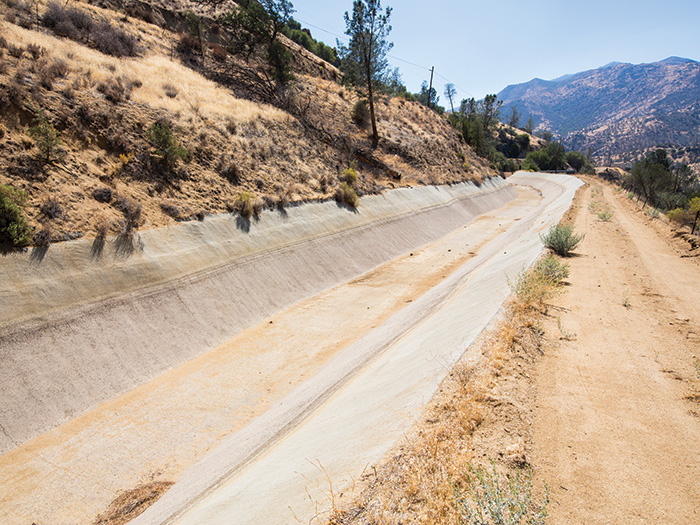California Climate Change Is Here to Stay. Is the U.S. Food Supply Doomed — or Will Growers Adapt?

“Despite all our accomplishments, we owe our existence to a six-inch layer of topsoil and the fact it rains.”
This (lightly paraphrased) quote from radio newsman Paul Harvey dates back to the previous century, but in California, now emerging from a 22-year drought, the words have never rung truer.
California’s water problems aren’t simply the result of less rain, though, or even rising temperatures. The rain and heat are also more erratic, making it more difficult to ration water from wet to dry years.
That in turn makes underwriting the sector very difficult.
“Ten years of retrospective data helps power the risk modeling, the underwriting scores, and allows insurance companies and lenders to apply the right rates and right metrics to different crops,” explained Ramsey Masri, a longtime California grape farmer and the CEO of agricultural risk insights firm Ceres Imaging.
But “the data that’s been used over the past ten years has been thrown into total chaos because of these massive unpredictable spikes.”
Whether California ignores water sustainability or tackles it head-on, this high-stakes bellwether market will have lessons for regions facing climate change the world over.
“Technology, science and consumer sentiment have all caught up,” Masri said. “People are like, ‘We gotta deal with this, and we gotta deal with it right now.’ ”
The Lay of the Land
California has always relied on the large but infrequent winter storms that the Pacific Jet Stream sends eastward to deposit oceanic moisture as snow on the Sierra Nevada Mountains. This year was a big one for snowfall, but that temporary bounty will do little to mend the long-term challenges faced by the state’s growers.
When this snowpack melts at the beginning of each growing season, it trickles down into the rivers and artificial lakes of more arid regions that, when irrigated, are ideal for cultivating heat-loving, water-intensive crops you won’t find anywhere else in the country. Roughly 80% of the world’s almonds grow here, as do 90% of the country’s avocados, 46% of its fruits and nuts, and 49% of its fresh market vegetables (not to mention 75% of its cut flowers).

Alvar Escriva-Bou, professor of civil and environmental engineering, UCLA; adjunct fellow, Water Policy Center, Public Policy Institute of California
But when California’s snow falls as rain and is quickly shed (or, worse, doesn’t fall at all), it’s not there when growers need it.
Greater disparity between wet and dry years only intensifies this shortage until even a wet winter like the one we’ve just seen makes little difference. As temperatures rise, precipitation evaporates more quickly or absorbs into parched soil rather than percolating down into California’s cultivated valleys.
And precipitation is only scratching the surface. Groundwater is just as vital to the state’s agriculture in dry years when river and reservoir levels drop. Like surface reservoirs, aquifers can be replenished during wet years and tapped during dry ones, but this resource gradually diminishes when more water is extracted than is replenished.
“The reality is that California has been overusing groundwater resources for more than 100 years,” said Alvar Escriva-Bou, professor of civil and environmental engineering at UCLA and adjunct fellow with the Public Policy Institute of California’s Water Policy Center.
“There’s a report from the 1920s, from the Department of Water Resources, saying that almost 200,000 acres of land in the San Joaquin Valley were overusing groundwater.”
Aquifers can be artificially replenished in the name of sustainability, but the practice of banking water underground wasn’t organized at a widespread level until the passage of the Sustainable Groundwater Management Act (SGMA) of 2014.
SGMA divides over 140 basins into more than 260 groundwater sustainability agencies — governing bodies that monitor groundwater consumption and grant members tradable credits in exchange for reserving their apportioned water. It’s a system designed to level out the extremes between wet and dry years. But even when it works flawlessly, it requires limiting consumption to what can be replenished over the long term.
During years when growers are forced to ration water (by purchasing credits to draw additional groundwater or, more commonly, by planting a smaller fraction of their land), seasonal crops like tomatoes, corn and melons are usually the first to go, sacrificed to keep fruit and nut orchards alive. The final alternative is simply to throw in the towel.
Federal multi-peril crop insurance offered under the federal crop insurance program can offset the loss of a year’s yield, but not the loss of orchards that take years to replace or the income lost to fallowing land by not planting in the first place.
“They’re predicting between half a million and a million acres will be out of production” in the San Joaquin Valley alone, said Gary Romoff, co-owner of Pauma Ranches Inc., a commercial citrus grove operator based in Southern California.
“Growers who are in that situation — they’re going to have to think about reducing their acres. They’ll have no other choice … There’s no insurance I know — there’s no planning to do except to plan for your own demise.”
The Add-On Effects
Many experts agree that this aridification is largely the result of permanent climate change.
“It’s not [appropriate] to call it drought anymore, because drought is a temporal issue,” said Escriva-Bou, adding that California’s water shortage “is caused by increased temperatures, not by reduced precipitation … The atmosphere is thirstier and it’s taking more water from the soil, [so] more of the water that rains is returning quicker to the atmosphere.
“The way we used to see dry and wet cycles — California is a Mediterranean climate and we’ve always had that,” Escriva-Bou said.
“But it’s changing and intensifying. On average, we have the same precipitation, but we have more variability between wet and dry years. We have wetter wets and drier dries.”
Growers will be first to feel the brunt of this. Crop insurance premiums have already spiked; combined with inflation in expenses like diesel, herbicide and labor, overhead costs could soon take a major bite out of growers’ profits.
Some may switch to different types of farming; others will choose to fallow more land or shut down entirely. It’s expected that the San Joaquin Valley will permanently lose up to a third of its irrigated land over the next 20 years.
As farms scale back or cease operation, certain foods will rise in cost, especially those that will need to be imported. In the Sacramento Valley, over half a million acres of rice are planted in a typical year, but in 2022, production of this water-intensive crop already facing a global shortage was cut in half.
The “salad bowl of the world” Salinas Valley also lost production in 2022, and the resulting spike in vegetable prices was a major contributor to last year’s inflationary crisis.
“We’re definitely importing more fruits and vegetables now than we have been,” Romoff said. Some of this is due to decreased domestic production, but “a lot of that’s not because of water but because of labor costs — they can produce certain labor-intensive crops cheaper in other areas.”
It’s hard to say how many jobs climate change will claim long-term. During the drought of 2014-2015, professors at UC Davis’ Center for Watershed Sciences estimated that fallowing 542,000 acres wiped out over 10,000 seasonal farm jobs; adding indirect losses like truck drivers and food plant workers, the total estimated jobs lost rose to 21,000.
“Without any action, we could lose 50,000 jobs just in San Joaquin Valley. But when you account for training, for new supplies and other things, you could see a much better outcome. We’ll be seeing some job losses for sure, but there’s a lot of uncertainty,” Escriva-Bou said.
“California’s trying to compete in a global market, and labor is much more expensive here than in many other places … That’s always been an issue in California. So it’s really difficult to make assumptions or estimates of the effect on labor in 10 or 20 years.”
Ag won’t be the only industry to scale back. As the cost of water rises, manufacturers will also begin eyeing greener pastures. Tourism, too, will take a hit.
“Towns will shrink,” Romoff predicted. “There’ll be less work. The fertilizer company will sell less fertilizer … There’ll be less economic activity. And that’s going to happen. There’s no way around it.”
Energy costs will also be impacted. The heat wave of 2020 robbed California of roughly half its hydroelectric power. If Lake Mead’s water level drops below 950 feet — which could happen as early as 2025 — the Hoover Dam will shut down and the states that rely on its power will be forced to turn to more expensive, more polluting fuel sources.
The residents of Los Angeles, Las Vegas, Phoenix and Denver rely on the Colorado River for their drinking water. Small but growing cities like Colorado Springs in Colorado and St. George in Utah (which pipe water in from afar) are already struggling to secure the water rights for construction permits, hampering new home construction.
As jobs disappear and access to domestic water constricts, migration could also rise, driving home prices and labor costs up or down and turning some regions into hotbeds of real estate speculation and others into ghost towns.
The Time to Act
While California’s climate change means both greater volatility and less available water overall, both of these risks can be mitigated with a proactive approach.
Groundwater storage shows real potential, Escriva-Bou said, and is worthy of greater public investment. “The system to do this is still in its infancy, but could in theory allow rainfall from wet years to be rationed across dry ones.”
Surface reservoirs, too, could be expanded to capture more water during wet seasons like the one we’ve just seen. (In fact, California voted to expand its surface reservoirs in 2014, but progress has so far been tied up in red tape.)

Ramsey Masri, CEO, Ceres Imaging
More efficient irrigation systems and a mix of less water-intensive crops could allow producers to continue farming while using less water. As the cost of pumping water increases, more sustainable irrigation practices make more economic sense, inciting growers to reduce consumption by, as Masri put it, “sciencing their way through their water utilization.”
Growers may also reconsider whether a region’s traditional crops are still appropriate for its evolving climate.
Masri cites the example of California grape growers migrating to Oregon to plant pinot: “It’s getting hotter; it’s getting drier — what grows best in these conditions? Not only is that beneficial to the grower but it’s beneficial to the insurer and the lender because we’ll see less losses. It’s absolutely in their interests to make good recommendations to the grower community. One of the value-adds these carriers can have to their farming community is to provide expert advice.”
With better Normalized Difference Vegetation Index (NDVI) data, growers and their insurers can more accurately model the causes of yield loss and respond accordingly, both by planting the crops more likely to thrive over the long term and by avoiding imminent threats.
Greater insight lets growers “control the things you can actually put your fingers on and dial up,” Masri said, “understanding that, at some point, Mother Nature’s going to deliver you a wallop. But at least if you can manage the areas that are within your bandwidth, you reduce your exposure pretty significantly. …
“That’s using things like machine vision and AI to see things weeks before a problem emerges, whether it’s a fungus or a deficiency in water or chemicals. I know I can’t control these extremes, but I can control these smaller elements, and when I add them all up — 3% here, 8% there — all of a sudden, I’ve de-risked my book a little bit and my loss ratio is improving,” Masri said.
“You’re building up resilience in the fields, you’re building up resilience in the plants, you’re being more careful about what you’re growing and where you’re growing it,” Masri continued.
“Shifting certain crops further away from those extreme heat zones or those more intense weather zones and taking better care of them when you do actually plant them … You can get more out of your existing fields by being more careful about your farming practices.”
Where land must be fallowed, public money or incentives for private investment could spur the installation of solar panels, for example, helping growers make up lost income while replacing lost hydropower with clean energy.
“There are opportunities, actually, to do this transition at the same time that we provide farmers with an alternative income and a way to accept this change,” Escriva-Bou said.
“California farmers have been adapting forever — not only for water issues. They adapt for many things, like labor shortages, global prices. In the past 30 or 40 years, we’ve seen a lot of changes in the crops that we’ve put in. In the 1980s, we had more than a million acres of cotton, and we have less than 200,000 now,” Escriva-Bou added.
“Farmers are also increasing productivity. The amount of profit that they make per acre or acre-foot of water, we have seen increase over time — like increasing yields in many crops. We can expect that this will keep happening in the future. Of course, it would be better if we didn’t have any problem with water … but even with reducing water use and reducing acreage, [the PPIC] estimated in its latest report that, even in California, agricultural output could grow,” Escriva-Bou said.
“It’s not the end of agriculture in California. California will adapt.” &










